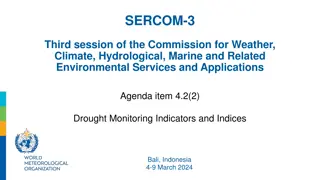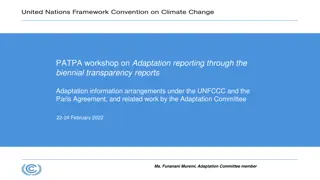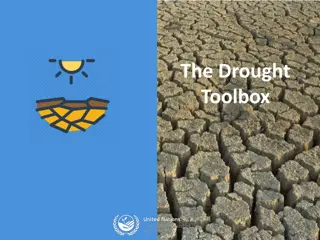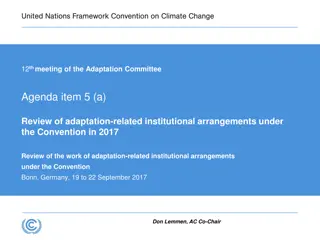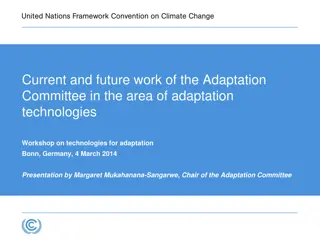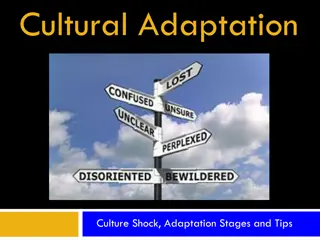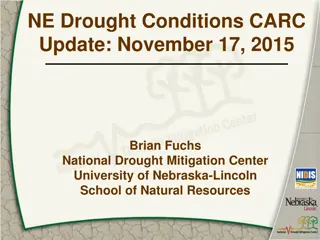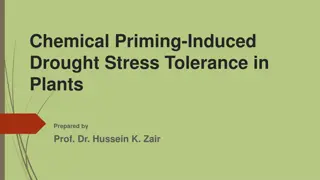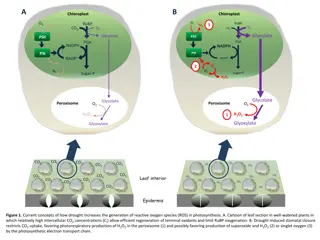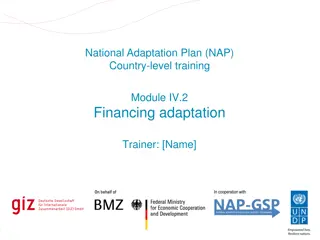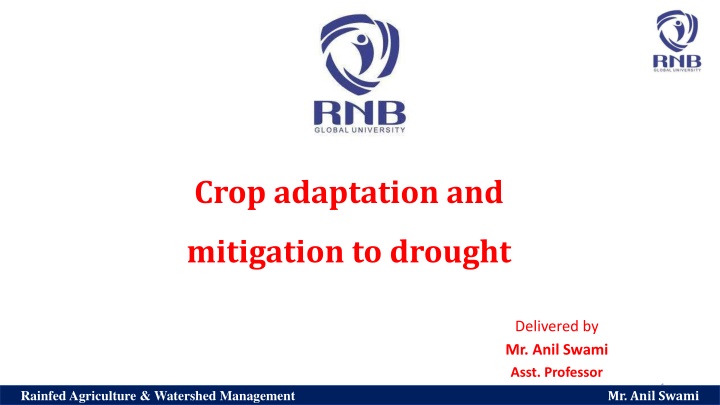
Crop Adaptation and Mitigation to Drought in Rainfed Agriculture
This presentation by Mr. Anil Swami, Assistant Professor, discusses the challenges of drought in rainfed areas, with a focus on crop adaptation strategies. It covers soil and climatic conditions, water harvesting techniques, contingent crop planning, seasonal rainfall patterns, watershed management, and soil conservation techniques. The presentation explains crop adaptations to water stress, such as drought resistance and escaping drought, and provides insights into mechanisms for overcoming moisture stress in plants.
Download Presentation

Please find below an Image/Link to download the presentation.
The content on the website is provided AS IS for your information and personal use only. It may not be sold, licensed, or shared on other websites without obtaining consent from the author. If you encounter any issues during the download, it is possible that the publisher has removed the file from their server.
You are allowed to download the files provided on this website for personal or commercial use, subject to the condition that they are used lawfully. All files are the property of their respective owners.
The content on the website is provided AS IS for your information and personal use only. It may not be sold, licensed, or shared on other websites without obtaining consent from the author.
E N D
Presentation Transcript
Crop adaptation and mitigation to drought Delivered by Mr. Anil Swami Asst. Professor 1 Mr. Anil Swami Mr. Anil Swami Rainfed Agriculture & Watershed Management Rainfed Agriculture & Watershed Management
Objective:- Tell the soil and climatic conditions prevalent in rainfed areas. Interpret various water harvesting techniques and their efficient utilization. Apply contingent crop planning for aberrant weather conditions. Examine the seasonal rainfall and different types of watershed and its components. Select soil and water conservation techniques to avoid their losses. 2 Mr. Anil Swami Rainfed Agriculture & Watershed Management
Crop Adaptations The ability of crop to grow satisfactorily under water stress is called drought adaptation. Adaptation is structural or functional modification in plants to survive and reproduce in a particular environment. Crops survive and grow under moisture stress conditions mainly by two ways: (i)Escaping drought and (ii)Drought resistance Mr. Anil Swami Rainfed Agriculture & Watershed Management
Flow chart showing different mechanisms for overcoming moisture stress Mr. Anil Swami Rainfed Agriculture & Watershed Management
Escaping Drought Evading the period of drought is the simplest means of adaptation of plants to dry conditions. Many short duration desert plants, (ephemerals), germinate with rains and mature in five to six weeks. These plants have no mechanism for overcoming moisture stress and are, therefore, are not drought resistant. Mr. Anil Swami Rainfed Agriculture & Watershed Management
In cultivated crops, the ability of a cultivar to mature before the soil dries is the main adaptation to growth in dry regions. However, only very few crops have such a short growing season to be called as ephemerals. Certain varieties of pearl millet mature within 60 days after sowing. Short duration pulses like cowpea, green-gram, black gram can be included in this category. In addition to earliness, they need drought resistance because there may be dry spells within the crop period of 60 days. The disadvantage about breeding early varieties is that yield is reduced with reduction in duration. Mr. Anil Swami Rainfed Agriculture & Watershed Management
Drought Resistance Plants can adopt to drought either by avoiding stress or by tolerating stress due to different mechanisms. These mechanisms provide drought resistance. Mr. Anil Swami Rainfed Agriculture & Watershed Management
Mr. Anil Swami Rainfed Agriculture & Watershed Management
Avoiding Stress Stress avoidance is the ability to maintain a favourable water balance, and turgidity even when exposed to drought conditions, there by avoiding stress and its consequences. A favourable water balance under drought conditions can be achieved either by: (i)Conserving water by restricting transpiration before or as soon as stress is experienced; or (ii)Accelerating water uptake sufficiently so as to replenish the lost water. Mr. Anil Swami Rainfed Agriculture & Watershed Management
Strategies for drought management The different strategies for drought management are discussed under the following heads. 1. Adjusting the plant population: The plant population should be lesser in dryland conditions than under irrigated conditions. The rectangular type of planting pattern should always be followed under dryland conditions. Under dryland conditions whenever moisture stress occurs due to prolonged dry spells, under limited moisture supply the adjustment of plant population can be done by low plant population. Mr. Anil Swami Rainfed Agriculture & Watershed Management
a) Increasing the inter row distance: By adjusting a greater number of plants within the row and increasing the distance between the rows reduces the competition during any part of the growing period of the crop. Hence it is more suitable for limited moisture supply conditions. b) Increasing the intra row distance: Here the distance between plants is increased by which plants grow luxuriantly from the beginning. There will be competition for moisture during the reproductive period of the crop. Hence it is less advantageous as compared to above under limited moisture supply. Mr. Anil Swami Rainfed Agriculture & Watershed Management
2. Mid-season corrections: The contingent management practices done in the standing crop to overcome the unfavourable soil moisture conditions due to prolonged dry spells are known as mid- season conditions. a) Thinning: This can be done by removing every alternate row or every third row which will save the crop from failure by reducing the competition b) Spraying: In crops like groundnut, castor, red gram, etc., during prolonged dry spells the crop can saved by spraying water at weekly intervals or 2 per cent urea at week to 10 days interval. c) Ratooning: In crops like sorghum and bajra, ratooning can practice as mid-season correction measure after break of dry spell. Mr. Anil Swami Rainfed Agriculture & Watershed Management
3. Mulching: It is a practice of spreading any covering material on soil surface to reduce evaporation losses. The mulches will prolong the moisture availability in the soil and save the crop during drought conditions. 4. Weed control: Weeds compete with crop for different growth resources ore seriously under dryland conditions. The water requirement of most of the weeds is more than the crop plants. Hence, they compete more for soil moisture. Therefore, the weed control especially during early stages of crop growth reduces the impact of dry spell by soil moisture conservation. Mr. Anil Swami Rainfed Agriculture & Watershed Management
3. Water harvesting and lifesaving irrigation: The collection of runoff water during peak periods of rainfall and storing in different structures is known as water harvesting. The stored water can be used for giving the lifesaving irrigation during prolonged dry spells. Mr. Anil Swami Rainfed Agriculture & Watershed Management
15 Mr. Anil Swami Mr. Anil Swami Rainfed Agriculture & Watershed Management Rainfed Agriculture & Watershed Management

